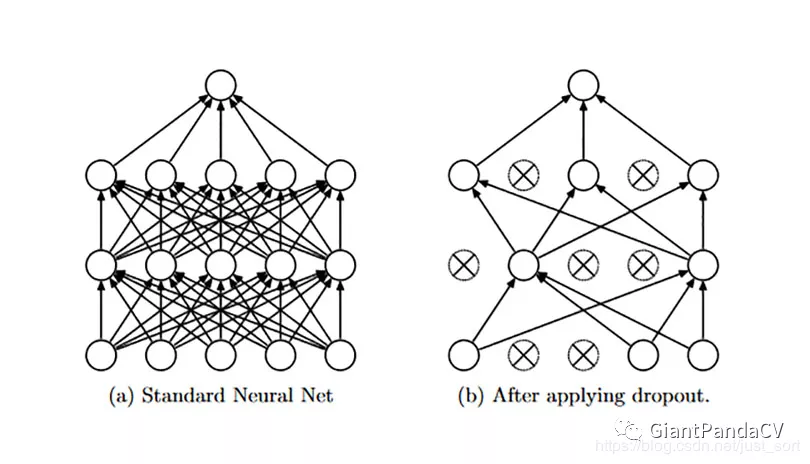前言 本次解析src/dropout.h和src/dropout.c两个文件,也即是Dropout层。
Dropout 在CNN中使用Dropout分成训练和测试两个阶段,在训练阶段,Dropout以一定的概率$p$随机丢弃一部分神经元节点,即这部分神经元节点不参与计算,如下图所示。
在训练时,每个神经元有概率$p$的可能性被保留下来,即Dropout的丢弃概率为$1-p$。在测试阶段,每个神经元都是存在的,权重参数$w$要乘以$p$成为$pw$。为什么测试阶段要乘以$p$呢?
考虑第一个隐藏层的一个神经元在Dropout之前的输出是$x$,那么Dropout之后的期望值为$E=px+(1-p)0$,在测试时该神经元总是激活的,为了保持同样的输出期望值并使得下一层也得到同样的结果,需要调整$x->px$。其中$p$是Bernoulli分布 (0-1分布)中值为1的概率。示意图如下:
Inverted Dropout 在训练的时候由于舍弃一些神经元,因此在测试的时候需要在激活的结果中乘上因子$p$进行缩放,但是这样需要对测试的代码进行修改并增加了测试时的运算量,十分影响测试时的性能。通常为了提高测试的性能,可以将缩放的工作转移到训练阶段,而测试阶段和不使用Dropout一致,这一操作就被叫作Inverted Dropout 。具体实现的时候只需要将前向传播Dropout时保留下来的神经元的权重乘上$\frac{1}{p}$即可。
代码解析 dropout_layer.h代码解析 1 2 3 4 5 6 7 8 9 10 11 12 13 14 15 16 17 18 19 20 21 22 23 24 25 26 #include "layer.h" #include "network.h" typedef layer dropout_layer;#ifdef __cplusplus extern "C" {#endif dropout_layer make_dropout_layer (int batch, int inputs, float probability, int dropblock, float dropblock_size_rel, int dropblock_size_abs, int w, int h, int c) ;void forward_dropout_layer (dropout_layer l, network_state state) void backward_dropout_layer (dropout_layer l, network_state state) void resize_dropout_layer (dropout_layer *l, int inputs) #ifdef GPU void forward_dropout_layer_gpu (dropout_layer l, network_state state) void backward_dropout_layer_gpu (dropout_layer l, network_state state) #endif #ifdef __cplusplus } #endif #endif
dropout_layer.cpp代码解析 1 2 3 4 5 6 7 8 9 10 11 12 13 14 15 16 17 18 19 20 21 22 23 24 25 26 27 28 29 30 31 32 33 34 35 36 37 38 39 40 41 42 43 44 45 46 47 48 49 50 51 52 53 54 55 56 57 58 59 60 61 62 63 64 65 66 67 68 69 70 71 72 73 74 75 76 77 78 79 80 81 82 83 84 85 86 87 88 89 90 91 92 93 94 95 96 97 98 99 100 101 102 103 104 105 106 107 108 109 110 dropout_layer make_dropout_layer (int batch, int inputs, float probability, int dropblock, float dropblock_size_rel, int dropblock_size_abs, int w, int h, int c) dropout_layer l = { (LAYER_TYPE)0 }; l.type = DROPOUT; l.probability = probability; l.dropblock = dropblock; l.dropblock_size_rel = dropblock_size_rel; l.dropblock_size_abs = dropblock_size_abs; if (l.dropblock) { l.out_w = l.w = w; l.out_h = l.h = h; l.out_c = l.c = c; if (l.w <= 0 || l.h <= 0 || l.c <= 0 ) { printf (" Error: DropBlock - there must be positive values for: l.w=%d, l.h=%d, l.c=%d \n" , l.w, l.h, l.c); exit (0 ); } } l.inputs = inputs; l.outputs = inputs; l.batch = batch; l.rand = (float *)xcalloc (inputs * batch, sizeof float )); l.scale = 1. /(1.0 - probability); l.forward = forward_dropout_layer; l.backward = backward_dropout_layer; #ifdef GPU l.forward_gpu = forward_dropout_layer_gpu; l.backward_gpu = backward_dropout_layer_gpu; l.rand_gpu = cuda_make_array (l.rand, inputs*batch); #endif if (l.dropblock) { if (l.dropblock_size_abs) fprintf (stderr, "dropblock p = %.2f l.dropblock_size_abs = %d %4d -> %4d\n" , probability, l.dropblock_size_abs, inputs, inputs); else fprintf (stderr, "dropblock p = %.2f l.dropblock_size_rel = %.2f %4d -> %4d\n" , probability, l.dropblock_size_rel, inputs, inputs); } else fprintf (stderr, "dropout p = %.2f %4d -> %4d\n" , probability, inputs, inputs); return l; } void resize_dropout_layer (dropout_layer *l, int inputs) l->inputs = l->outputs = inputs; l->rand = (float *)xrealloc (l->rand, l->inputs * l->batch * sizeof float )); #ifdef GPU cuda_free (l->rand_gpu); l->rand_gpu = cuda_make_array (l->rand, l->inputs*l->batch); #endif } void forward_dropout_layer (dropout_layer l, network_state state) int i; if (!state.train) return ; for (i = 0 ; i < l.batch * l.inputs; ++i){ float r = rand_uniform (0 , 1 ); l.rand[i] = r; if (r < l.probability) state.input[i] = 0 ; else state.input[i] *= l.scale; } } void backward_dropout_layer (dropout_layer l, network_state state) int i; if (!state.delta) return ; for (i = 0 ; i < l.batch * l.inputs; ++i){ float r = l.rand[i]; if (r < l.probability) state.delta[i] = 0 ; else state.delta[i] *= l.scale; } }


